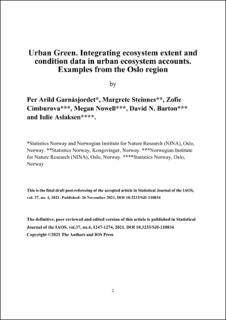| dc.contributor.author | Garnåsjordet, Per Arild | |
| dc.contributor.author | Steinnes, Margrete | |
| dc.contributor.author | Cimburova, Zofie | |
| dc.contributor.author | Nowell, Megan | |
| dc.contributor.author | Barton, David Nicholas | |
| dc.contributor.author | Aslaksen, Iulie | |
| dc.date.accessioned | 2022-03-28T09:02:38Z | |
| dc.date.available | 2022-03-28T09:02:38Z | |
| dc.date.created | 2021-12-17T14:50:02Z | |
| dc.date.issued | 2021 | |
| dc.identifier.citation | Statistical Journal of the IAOS. 2021, 1247-1274. | en_US |
| dc.identifier.issn | 1874-7655 | |
| dc.identifier.uri | https://hdl.handle.net/11250/2987866 | |
| dc.description.abstract | The article enhances the knowledge base for the assessment of urban ecosystem services, within the United Nations System of Environmental-Economic Accounting Ecosystem Accounting (SEEA EA), recently adopted as an international statistical standard. The SEEA EA is based on spatial extent accounts (area of ecosystems) and biophysical condition accounts (ecological state of ecosystems). Case studies from the Oslo region are explored, combining land use/land cover maps from Statistics Norway with satellite data. The results illustrate that a combination of land use/land cover data for ecosystem extent and detailed satellite data of land cover provides a much higher quality for the interpretation of extent and condition variables. This is not only a result of applying spatial analysis, but a result of applying knowledge about the information categories from satellite data of land cover, to official statistics for built-up land in urban areas that until now have not been identified. Moreover, the choice of spatial units should reflect that modelling of different ecosystem services, as a basis for trade-offs in urban planning, requires a combination of different spatial approaches to capture urban green elements. Ecosystem accounting, ecosystem services, urban ecosystems, spatial analysis, land use maps, land cover maps | en_US |
| dc.language.iso | eng | en_US |
| dc.rights | Navngivelse-Ikkekommersiell-DelPåSammeVilkår 4.0 Internasjonal | * |
| dc.rights.uri | http://creativecommons.org/licenses/by-nc-sa/4.0/deed.no | * |
| dc.title | Urban green. Integrating ecosystem extent and condition data in urban ecosystem accounts. Examples from the Oslo region | en_US |
| dc.type | Journal article | en_US |
| dc.description.version | acceptedVersion | en_US |
| dc.rights.holder | Copyright ©2022 IOS Press. | en_US |
| dc.subject.nsi | VDP::Matematikk og Naturvitenskap: 400::Zoologiske og botaniske fag: 480::Økologi: 488 | en_US |
| dc.subject.nsi | biogeografi | en_US |
| dc.source.pagenumber | 1247-1274 | en_US |
| dc.source.volume | 37 | en_US |
| dc.source.journal | Statistical Journal of the IAOS | en_US |
| dc.source.issue | 4 | en_US |
| dc.identifier.doi | 10.3233/SJI-210834 | |
| dc.identifier.cristin | 1970010 | |
| dc.relation.project | Norges forskningsråd: 255156 | en_US |
| dc.relation.project | EU – Horisont Europa (EC/HEU): 817527 | en_US |
| cristin.ispublished | true | |
| cristin.fulltext | postprint | |
| cristin.fulltext | postprint | |
| cristin.qualitycode | 0 | |

